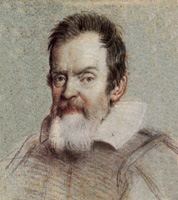 The
Italian astronomer Galileo
Galilei (1564-1642) used the
recently invented telescope
to open the modern era of astronomy.
Among his discoveries were
dark spots on the Sun. Chinese
astronomers had known about
Sunspots for centuries, but
Europeans were surprised by
what Galileo described. The
Italian astronomer Galileo
Galilei (1564-1642) used the
recently invented telescope
to open the modern era of astronomy.
Among his discoveries were
dark spots on the Sun. Chinese
astronomers had known about
Sunspots for centuries, but
Europeans were surprised by
what Galileo described.
While
it's commonly held that Galileo
went blind from observing the
Sun directly with his eyes,
this belief has little support.
Galileo went blind late in
life, most likely from an eye
disease, and made a number
of important observations
after his 1612 investigation
of Sunspots. He reported using
the telescope to look at the
Sun only at Sunset (when its
light is far less intense)
and his assistant discovered
that the Sun’s light
could be projected onto white
paper with the telescope – thus
preventing damage to the eyes.
Caution: Never look directly at the sun!
Since
Galileo’s time, tools
for observing the Sun have
become very sophisticated.
Today, scientists use a variety
of ground-based and space-based
telescopes to study the Sun
in many different wavelengths.

|

